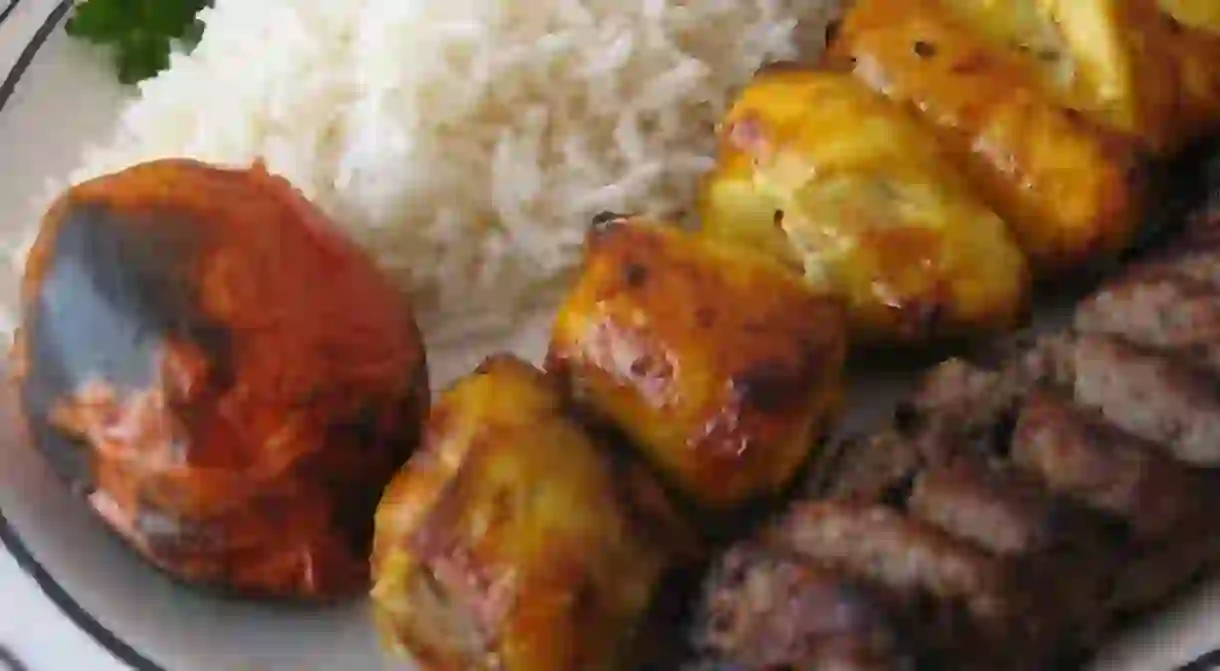A Brief History of Chelow Kebab in Iran

Food is always an exciting topic of conversation and brings people together like few other things can. While Iranian cuisine is varied and uses seasonal ingredients, the most well-known of them all, and with good reason, is chelow kebab. Check out a brief history of this beloved dish and all its varieties.
Rumor has it that one of the things Persian Qajar king Naser al-Din Shah loved the most was chelow kebab from the Caucasus, which was different from the Iranian kind in that it was made with veal, mutton, or game birds. This dish eventually became one of the most loved recipes and the national dish of Iran.
The chelow kebab that we think of today comes in many forms. First, it’s necessary to understand chelow, steamed white rice sprinkled with a layer of saffron-soaked rice to give it a hint of color and flavor. While it’s still warm, the rice is topped with a slab of butter so that it can slowly melt and be mixed in with some sumac, a tart red spice.
The kebab part of this traditional dish comes in many forms. Kubideh is the most classic and consists of ground beef or lamb mixed with chopped onions, which is then skillfully molded on the skewers. A perfect consistency of fat, meat, and onions is necessary so that the meat doesn’t slide off while grilled. If you order kubideh, you can count on a standard two skewers.

Barg is a lamb or beef fillet marinated in onions and olive oil. Tender, yet not so much as kubideh, this is normally served on a single skewer. To get the best of both worlds, you can order a combination of kubideh and barg, referred to as sultani, which, as the name suggests, means that the meal is fit for a sultan.
Joojeh kebab is grilled chicken with olive oil and saffron and can be ordered with or without the bone, but many Iranians think it’s tastier with it. Again, if you can’t seem to decide which one to order, taste two in one with bakhtiari, skewers of alternating chunks of kubideh and joojeh kebab.

You can get to some heavy duty kebab eating with shishlik. This skewered lamb is marinated and grilled with the bones—eating the chunks of meat off the bone might have you feeling like a puma. Shishlik comes from the outskirts of the holy city of Mashhad, specifically the Shandiz area.
https://www.instagram.com/p/pwagrKJS14/?taken-by=mypersiancorner
Kebab torsh, or sour kebab, is a specialty of the northern Gilan province, and one that you shouldn’t miss. Sirloin chunks are marinated in a thick sauce of crushed walnuts, pomegranate paste, chopped parsley, crushed garlic, and olive oil. Once grilled, this mouthwatering dish has a tangy bite to it that will have you coming back for more.
All chelow kebab dishes come with grilled tomatoes. It’s customary to scrape the insides out, leaving the skins behind. Other extras include raw onions (which you bite right into), a plate of fresh herbs, and plain yogurt or yogurt with chopped shallots. The traditional drink to wash it all down with is doogh, a salty, sometimes carbonated drink of yogurt and water with dried mint. Make sure you don’t have any important business to do afterward because eating chelow kebab in its most traditional form is the perfect recipe to knock you out into a food coma. Maybe that’s why many traditional restaurants don’t have tables, but rather beds where you can stretch your legs after you’ve enjoyed a delicious meal.

You’re bound to try chelow kebab while visiting Iran, so check out some of the restaurants we recommend.













